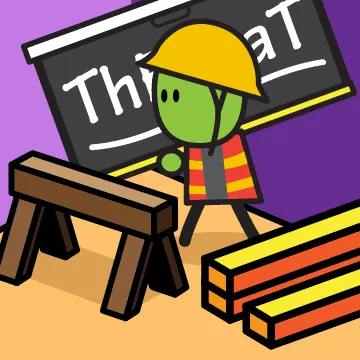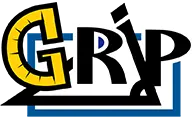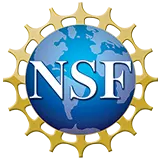
ThEMaT I
Thought Experiments in Mathematics Teaching IIn order to elicit discussions among groups of experienced teachers, ThEMaT developed and used animations of cartoon characters to represent classroom scenarios in U.S. high school algebra and geometry classrooms. These animations represented episodes that intentionally straddled the boundaries between what is more and less customary in classrooms. Using discourse analysis techniques, the project investigators examined focus group discussions to understand whether and how the instructional practices represented in the scenarios fall within what experienced mathematics teachers might consider reasonable to do in the classroom. For the production of those animations, the ThEMaT I Project created casts of cartoon characters (including ThExpians B and ThExpians M). The ThExpians B characters and the animations, have been reused in later projects as well as in the LessonSketch platform (developed in a subsequent project).
As a theoretical contribution, ThEMaT I helped develop the notion of an instructional situation as a resource to account for the subject-specificity of classroom instruction: These can be described as the system of norms that regulate how work in a type of problem provides students opportunities to learn and evidence of students’ learning of a particular kind of knowledge. Instructional situations investigated in the context of ThEMat I include installing theorems and doing proofs in geometry, and solving equations and doing word problems in algebra. The project helped characterize those situations in terms of norms—observer statements of implicit regulations that classroom participants act as-if they were expected to follow. To explore those norms, both whether they were applicable and what the rationality that undergirded them was, the project designed and produced animations of classroom scenarios in which such norms had been breached. Researchers examined the conversations among practitioners about those scenarios to find evidence that practitioners perceived a breach of business as usual. The notion that some departures from norms might be justifiable came as a result of the inspection of those conversations. In efforts to name the sources of justification, the project contributed the proposal that the work of teaching is accountable to stakeholders, or that teachers need to respond to professional obligations to the discipline of mathematics, the students as individuals, social expectations and values, and the policies and practices of organizations larger than the classroom (e.g., the department, school, system, etc.).
As a methodological contribution, the project contributed a variant of the ethnomethodological breaching experiment—demonstrating that such experiments could be done virtually by immersing practitioners in videos and animations of practice and analyzing their response to those representations as data informing on their practice. The project also demonstrated how some resources from Systemic Functional Linguistics (in particular, the modality system) can be used to analyze stances towards norms in the discourse of groups of teachers.
Papers that showcase some of this work include
| Title | Author(s) | Citation | Date |
|---|---|---|---|
| Instructional alternatives via a virtual setting: Rich media supports for teacher development | Chazan D, Herbst P, Sela H | Chazan, D., Herbst, P. & Sela, H. (2011). Instructional alternatives via a virtual setting: Rich media supports for teacher development. In Zaslavsky, O. and Sullivan, P. (Eds.). Constructing knowledge for teaching secondary mathematics: Tasks to enhance prospective and practicing teacher learning (pp. 23-37). New York: Springer | 2011 |
| Producing a Viable Story of Geometry Instruction: What Kind of Representation Calls Forth Teachers’ Practical Rationality? | Herbst P, Chazan D | Herbst, P. and Chazan, D. (2006). Producing a Viable Story of Geometry Instruction: What Kind of Representation Calls Forth Teachers’ Practical Rationality? In Alatorre, S., Cortina, J.L., Sáiz, M., and Méndez, A.(Eds) Proceedings of The 28th Annual Meeting of the North American Chapter of the International Group for the Psychology of Mathematics Education (Vol 2, 213-220). Mérida, México: Universidad Pedagógica Nacional | 2006 |
| The nature and role of proof when installing theorems: The perspective of geometry teachers | Miyakawa T, Herbst P | Miyakawa, T. and Herbst, P. (2007). The nature and role of proof when installing theorems: The perspective of geometry teachers. In Proceedings of the 31th Annual Meeting of the International Group for the Psychology of Mathematics Education. Seoul, Korea | 2007 |
| Geometry teachers’ perspectives on convincing and proving when installing a theorem in class | Miyakawa T, Herbst P | Miyakawa, T. and Herbst, P. (2007). Geometry teachers’ perspectives on convincing and proving when installing a theorem in class. In Proceedings of the 29th Annual Meeting of the North American Chapter of the International Group for the Psychology of Mathematics Education. Reno, NV. | 2007 |
| ThEMaT’s virtual settings: Practicing math teaching with web-based interactive rich-media technologies | Chieu V, Weiss M, Herbst P | Chieu, V.M., Weiss, M., & Herbst, P.G. (2008). ThEMaT’s virtual settings: Practicing math teaching with web-based interactive rich-media technologies. Proceedings of the 19th SITE International Conference on Information Technology and Teacher Education, Las Vegas, NV, March 3-7, pp. 4587–4592 | 2008 |
| Learning to teach: Web-based interactive richmedia technologies supporting cognitive flexibility in teacher education | Chieu V, Herbst P | Chieu, V.M. & Herbst, P.G. (2008). Learning to teach: Web-based interactive richmedia technologies supporting cognitive flexibility in teacher education. Proceedings of the 19th SITE International Conference on Information Technology and Teacher Education, Las Vegas, NV, March 3-7, pp. 4579–4586 | 2008 |
| Using Web 2.0 Interactive Richmedia Technologies in Mathematics Teacher Development | Chieu V, Weiss M, Herbst P | Chieu, V. M., Weiss, M. & Herbst, P. (2009). Using Web 2.0 Interactive Richmedia Technologies in Mathematics Teacher Development. In C. Crawford et al. (Eds.), Proceedings of Society for Information Technology and Teacher Education International Conference 2009 (pp. 3619-3624). Chesapeake, VA: AACE | 2009 |
| Representations of mathematics teaching and their use in teacher education: What do we need in a pedagogy for the 21st century? | Herbst P, Bieda K, Chazan D, González G | Herbst, P., Bieda, K., Chazan, D., and González, G. (2010). Representations of mathematics teaching and their use in teacher education: What do we need in a pedagogy for the 21st century? Proceedings of the 2010 Annual PME-NA conference. Columbus, OH: Ohio State University | 2010 |
| The use of animations and online communication tools to support mathematics teachers in the practice of teaching | Chieu V, Herbst P, Weiss M | Chieu, V. M., Herbst, P., & Weiss, M. (2010). The use of animations and online communication tools to support mathematics teachers in the practice of teaching. In Gomez, K., Lyons, L., & Radinsky, J. (Eds.), Learning in the Disciplines: Proceedings of the 9th International Conference of the Learning Sciences (ICLS 2010) - Volume 2, Short Papers, Symposia, and Selected Abstracts (pp. 290-291). International Society of the Learning Sciences: Chicago, IL | 2010 |
| Representations of mathematics teaching and their use in transforming teacher education: Contributions to a pedagogical framework | Herbst P, Aaron W, Bieda K, González G, Chazan D | Herbst, P., Aaron, W., Bieda, K., González, G., and Chazan, D. (2011). Representations of mathematics teaching and their use in transforming teacher education: Contributions to a pedagogical framework. Discussion document for the working group ‘representations of mathematics teaching’. Proceedings of the 2011 Annual PME-NA Conference. Reno, NV | 2011 |
| Supporting mathematics teachers’ online discussion with the use of animated classroom stories as reference point | Chieu V, Herbst P | Chieu, V.M. & Herbst, P.G. (2011). Supporting mathematics teachers’ online discussion with the use of animated classroom stories as reference point. In Proceedings of the 11th IEEE International Conference on Advanced Learning Technologies (pp. 479-481). Washington, DC: IEEE Computer Society | 2011 |
| Representations of mathematics teaching and their use in transforming teacher education: The role of approximations of practice | Herbst P, Aaron W, Bieda K, Moore-Russo D | Herbst, P., Aaron, W., Bieda, K., and Moore-Russo, D. (2012). Representations of mathematics teaching and their use in transforming teacher education: The role of approximations of practice. Proceedings of the 34th Annual Meeting of the North American Chapter of the International Group for the Psychology of Mathematics Education. Kalamazoo, MI. Available on Deep Blue at The University of Michigan | 2012 |
| Methodologies for the study of instruction in mathematics classrooms | Herbst P, Chazan D | Herbst, P. and Chazan, D. (2009). Methodologies for the study of instruction in mathematics classrooms. Recherches en Didactique des Mathématiques, 29(1), 11-32 | 2009 |
| Designing representations of trigonometry instruction to study the rationality of community college teaching | Mesa V, Herbst P | Mesa, V. and Herbst, P. (2011). Designing representations of trigonometry instruction to study the rationality of community college teaching. ZDM Mathematics Education. 43(1), 41–52 | 2011 |
| Geometry teachers’ mathematical sensibility: The role of theory-building and problem-solving in the secondary Geometry course | Weiss M, Herbst P | Weiss, M., & Herbst, P. (2015). Geometry teachers' mathematical sensibility: The role of theory-building and problem-solving in the secondary Geometry course. Educational Studies in Mathematics. 89(2), 205-229 | 2015 |
| Seeing a colleague encourage a student to make an assumption while proving: What teachers put to play in casting an episode of geometry instruction | Nachlieli T, Herbst P, González G | Nachlieli, T., & Herbst, P., with González, G. (2009). Seeing a colleague encourage a student to make an assumption while proving: What teachers put to play in casting an episode of geometry instruction. Journal for Research in Mathematics Education, 40(4), 427-459. | 2009 |
| Las tareas matemáticas como instrumentos en la investigación de los fenómenos de gestión de la instrucción: un ejemplo en geometría [Mathematical tasks as instruments for research on the phenomena of instruction management: An example in geometry] | Herbst P | Herbst, P. (2012). Las tareas matemáticas como instrumentos en la investigación de los fenómenos de gestión de la instrucción: un ejemplo en geometría [Mathematical tasks as instruments for research on the phenomena of instruction management: An example in geometry]. Avances de Investigación en Educación Matemática, 1, 5-22. | 2012 |
| Challenges of particularity and generality in depicting and discussing teaching. | Chazan D, Herbst P | Chazan, D., & Herbst, P. (2011). Challenges of particularity and generality in depicting and discussing teaching. For the Learning of Mathematics, 31(1), 9-13. | 2011 |
| Constructing plausible, but uncommon stories: Gaining subversive insight into the school mathematics tradition. | Chazan D, Gilead S, Cochran K | Chazan, D., Gilead, S., & Cochran, K. (2018). Constructing plausible, but uncommon stories: Gaining subversive insight into the school mathematics tradition. In R. Zazkis & P. Herbst (Eds.), Scripting approaches in mathematics education (pp. 53-72). Cham, Switzerland: Springer. | 2018 |
| Teachers’ perceptions of students’ mathematical work while making conjectures: An examination of teacher discussions of an animated geometry classroom scenario. | Aaron W, Herbst P | Aaron, W., & Herbst, P. (2015). Teachers’ perceptions of students’ mathematical work while making conjectures: An examination of teacher discussions of an animated geometry classroom scenario. International Journal of STEM Education, 2(10), 1-13. | 2015 |
| The teacher’s perspective on the separation between conjecturing and proving in high school geometry classrooms | Aaron W, Herbst P | Aaron, W., & Herbst, P. (2019). The teacher’s perspective on the separation between conjecturing and proving in high school geometry classrooms. Journal of Mathematics Teacher Education, 22(3), 231-256. | 2019 |
| “You Are Learning Well My Dear”: Shifts in Novice Teachers’ Talk About Teaching During Their Internship | Bieda K, Sela H, Chazan D | Bieda, K., Sela, H., and Chazan, D. (2015). "You are learning well my dear": How student teaching influences intern teachers talk' about teaching during their internship. Journal of Teacher Education, (66). | 2015 |
| A deeper look at how teachers say what they say: A quantitative modality analysis of teacher-to-teacher talk | Kosko K, Herbst P | Kosko, K. and Herbst, P. (2011). A deeper look at how teachers say what they say: A quantitative modality analysis of teacher-to-teacher talk., Teaching and Teacher Education, (28, pp. 589). | 2011 |
| Animations of Classroom Interaction: Expanding the Boundaries of Video Records of Practice | Chazan D, Herbst P | Chazan D. and Herbst, P. (2012). Animations of Classroom Interaction: Expanding the Boundaries of Video Records of Practice., Teachers' College Record, 114(3) | 2012 |
| Using comics-based representations of teaching, and technology, to bring practice to teacher education courses | Herbst P, Chazan D, Chen C, Chieu VM, Weiss M | Herbst, P., Chazan, D., Chen, C., Chieu, V., and Weiss, M. (2011). Using comics-based representations of teaching, and technology, to bring practice to university 'methods' courses., ZDM-The international journal of mathematics education. | 2011 |
| Designing an intelligent teaching simulator for learning to teach by practicing | Chieu V M, Herbst P | Chieu, V.M. and Herbst, P. (2011). Designing an Intelligent Teaching Simulator for Learning by Practicing in the Practice of Mathematics Teaching., ZDM-The international journal of mathematics education. | 2011 |
| Is the Role of Equations in the Doing of Word Problems in School Algebra Changing? Initial Indications From Teacher Study Groups | Chazan D, Sela H, Herbst P | Chazan, D. Sela, H., and Herbst, P. (2012). Is the role of equations in the doing of word problems in school algebra changing? Initial indications from teacher study groups., Cognition and Instruction, (30(1), pp. 1-38). | 2012 |
| Effect of an Animated Classroom Story Embedded in Online Discussion on Helping Mathematics Teachers Learn to Notice | Chieu VM, Herbst P, Weiss M | Chieu, V., Herbst, P., and Weiss, M. (2011). Effect of an Animated Classroom Story Embedded in Online Discussion on Helping Mathematics Teachers Learn to Notice., Journal of the Learning Sciences, 20(4), (pp. 589). | 2011 |
| Opening the closed text: the poetics of representations of teaching | Weiss M | Weiss, M. (2011). Opening the closed text: The poetics of representations of teaching, ZDM-The international journal of mathematics education. | 2011 |
| Studying the Practical Rationality of Mathematics Teaching: What Goes Into “Installing” a Theorem in Geometry? | Herbst P, Nachlieli T, Chazan D | Patricio Herbst, Talli Nachlieli, and Daniel Chazan. (2011). Studying the Practical Rationality of Mathematics Teaching: What Goes Into “Installing” a Theorem in Geometry?, Cognition and Instruction, 29(2), (pp. 1). | 2011 |
| Exploring the Practical Rationality of Mathematics Teaching through Conversations about Videotaped Episodes: The Case of Engaging Students in Proving | Herbst P, Chazan D | Patricio Herbst and Daniel Chazan. (2003). Exploring the Practical Rationality of Mathematics Teaching through Conversations about Videotaped Episodes: The Case of Engaging Students in Proving, For the Learning of Mathematics, (23, pp. 2). | 2003 |

